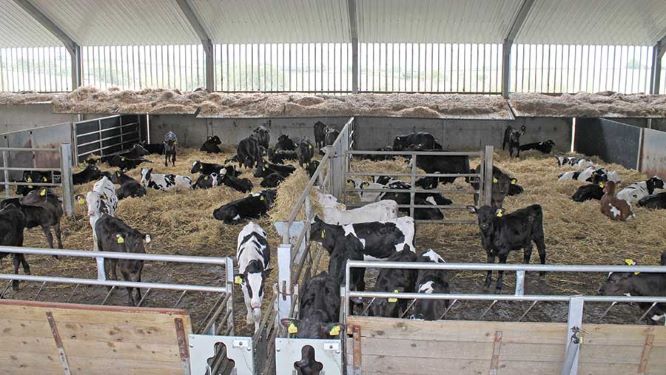“Keep your maternity and calving pens as clean as possible,” Dr Emer Kennedy, Teagasc researcher, told farmers at the state agency’s dairy conference – which carried the theme of turning challenges into opportunities – earlier this week.
She presented a paper on management and housing guidelines to achieve excellent calf welfare, which she co-authored with Alison Sinnott.
During her address, she highlighted that one of the most important aspects of calf housing is hygiene.
She went on to say: “When we think of the calf when it is in utero, there is no transfer of immunoglobulins between the cow and calf.”
“Unlike a human baby, when we are born, we have a functioning immune system.”
“But with a calf, the placenta is separating the maternal and foetal blood supplies, so when the calf is born, it is almost entirely dependent on the absorption of maternal immunoglobulins from colostrum.”
“So, you could imagine if you had a newborn baby, there is no way that you would dream of putting it into a dirty environment.”
“Similarly, if a calf with no developed immune system is born into a dirty environment, of course, it is at greater risk of contracting or picking up diseases”
“We want to move to a situation where we have a nice, clean bed of dry straw for calves to be born,” she added.
Space requirements
She then discussed a calf’s space requirements and firstly, pointed to the legal minimum requirement of 1.5 metres squared for those less than 150kgs, which she described as a pre-weaned calf.
She outlined that “obviously, the more space you can afford to give the calf, the better”.
“But if we are talking about in terms of spring 2023, there is limited time to get yourself ready between now and then, so we are going to work on that figure for today.”
She once again shed light on a Teagasc Moorepark survey – which we highlighted findings from in a previous article – which found that 90% of calf houses had sufficient capacity.
It is interesting to note that more than 85% had expanded and, even with that, had sufficient space for calves.
The survey did, however, show that where calves had more space, they had fewer health issues, and they were “free to express their behaviour”, she added.
“The question then arises, if calves have to stay on-farm longer, will there be enough space for them?”
“Another thing to consider is what sort of group size you are going to put calves in. Smaller group sizes tend to have less disease spread. Our survey found that over 75% of farmers kept calves in groups of less than twelve.”
She told farmers that based on Teagasc research, delaying the age of sale from 3 to 8 weeks can increase space requirements by approximately 50%.
Dr Kennedy outlined that a lower 6-week calving rate did not “significantly” impact space requirements.
She stressed that “if you are selling calves at 6 weeks of age, you need to have, more or less, enough space for 100% of your calves”.
How to measure your shed
She gave an example of a shed with six equally sized pens. You can measure the length and width of each pen and then divide by 1.5, to calculate the number of calves per pen and then multiply this by the number of pens in the shed, to calculate the total.
When providing this guide, she stressed the need to ensure there is sufficient air and floor space in sheds.
Lastly, she touched on air capacity:
- Multiple total shed length by total shed width by total shed height
- Requirements: 7m3 up to 2 months;
- 10m3 thereafter.





